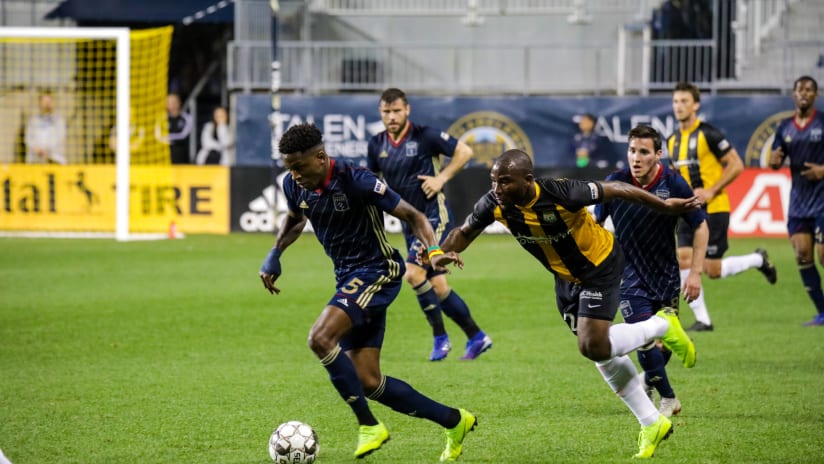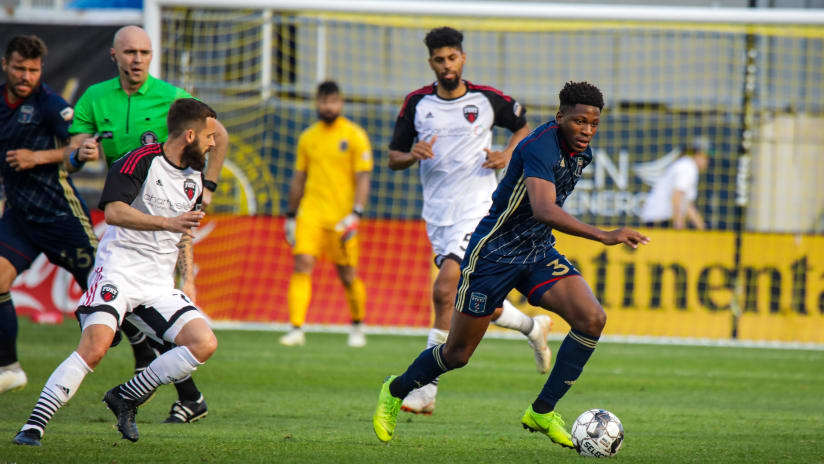This one should feel like a playoff game.
The Union and New York Red Bulls both have a lot to play for, and both clubs believe they have the talent to trounce the other if things go their way. A taut 0-0 draw in New Jersey earlier this season showed that Philadelphia Union could find holes in Red Bulls’ vaunted press-and-direct-play system; a 2-1 win in Philadelphia in the Open Cup confirmed it.
But since they last faced the Union, Red Bulls have undergone their first coaching change since 2015. Jesse Marsch departed for an assistant’s role in Leipzig and left Chris Armas to guide the team he had assiduously built into a field-compressing powerhouse.
Armas has filled Marsch’s shoes admirably. New York has one loss since July, a 3-0 pounding at the hands of Montreal Impact. They have knocked off Atlanta United with surprising ease and dispatched both LAFC and Sporting Kansas City. It is difficult to argue that Red Bulls are anything but one of the top two teams in the league this season. The question now is whether the Union, who have eyes on third place in the Eastern Conference, have closed the gap to the point where they can go toe-to-toe with Red Bulls in a playoff atmosphere.

Whence Kaku
Red Bulls’ expensive new playmaker Kaku hardly missed a beat when Armas replaced Marsch in early July, but since that month ended he has not collected a single assist. ...What gives?
For the first four months of the season, Kaku was a revelation as a provider. He had six assists through June and was averaging 0.47 Expected Goals + Expected Assists/96 minutes (according to American Soccer Analysis’ interactive database).
The Argentinian, who now plays for Paraguay’s national team, averaged 1.9 key passes per match and 1.9 shots per match; he was filthy.
When Armas took over in July, Kaku went on a tear. After New York lost to NYC, Kaku reeled off four straight games with an assist, and he added at least one shot in three of the four matches. But something was missing: the shots on target. Prior to July, Kaku was averaging about 1.2 shots on target per match. Suddenly, he went on a seven match streak without a single shot on frame. Still productive, certainly, but not the dynamic dual-threat that Red Bulls envisioned.
And then the assists dried up.
Kaku has zero assists since July, and his Expected Assists per match number has dropped from 0.28 under Marsch to 0.11 since August began (putting him below both Marky Delgado of Toronto and CJ Sapong of the Union). His Key Passes per game have fallen from 1.9 to 1.08, and Marc Rzatkowski now profiles far more like the top creator on Red Bulls.
But Kaku hasn’t simply disappeared. Instead, he appears to be trending toward becoming the end point of moves rather than the final passer. His Expected Goals per match have gone from 0.20 under Marsch to 0.35 since August began, and his xG+xA is virtually the same as it was during Marsch’s tenure. Kaku is still productive, but he’s producing in a different way than he did in the past.
And there’s more: Kaku is not only taking more shots, he’s also becoming more involved in New York’s buildup play. His Expected Buildup number, which reflects the amount of Expected Goals earned on possessions in which Kaku touched the ball but didn’t make the final pass or take the actual shot has gone through the roof since July. Under Marsch this number was 0.64 (so 0.64 Expected Goals per game were accrued from possessions in which Kaku touched the ball but didn’t make the final pass or take a shot). Since the start of August that xBuildup number has risen to an impressive 1.01 per match.
In sum, Kaku remains a key part of the New York attack, but he is no longer the playing the final provider role he was under Marsh (for comparison — Borek Dockal’s xG+xA this season is 0.54, which is nearly identical to Kaku’s best month of work in July).

How it works
The not-so-secret secret to Red Bulls success is, in simple terms, two-fold. First, you compress the field with angled pressure that pushes the ball toward one side. Once a pass is made out of the back, you flood the area around the ball with numbers and play any loose ball forward as quickly as possible.
The key is to be better at transitioning from defense to attack than the opposition is at transitioning from attack to defense. Many teams — the Union included — look to space players out in possession in order to create larger gaps between defensive players. The reward is a more open defense, but the risk is that you are quite open yourself if you lose the ball. The Red Bulls seek to move forward before you can recover any defensive shape, pushing the ball to the front and capitalizing on Bradley Wright-Phillips’ excellent movement in the box to quickly create and convert opportunities.
How to combat it
It sounds simple enough: Just play the ball to the other side of the pitch when Red Bulls look to trap you.
It really isn’t, though. Red Bulls know their pressing triggers extremely well: Short passes in the center, backward passes, sometimes a ball to a fullback if a team pushes the winger high, anything played vertically into a channel.
That means that when you receive the ball, your second touch is the touch of death. If that second touch is not one that gets you past the first man and into space, it better be a pass, because otherwise you are about to enter a world of chaos.
There are two key tactics the Union have used to counter Red Bulls in the past. The first is to basically do the soccer equivalent of a trust fall and play blind cross-field balls out of pressure. As long as you target a specific area, there should be a player looking to receive in that zone. The Union facilitate this by pulling Red Bulls’ shape vertically. That is, they look to make Bradley Wright-Phillips step away from his midfield as he looks to move between the center backs. This makes Red Bulls cover more ground once they trigger their pressure, providing a vital extra second or two for the ball-carrier to hit a longer pass.
Second, the Union show a willingness to take on the first man in midfield before distributing the ball. Red Bulls’ first presser takes an angle designed to force the ball-carrier to play a pass into specific areas that can then be trapped. If that first man is beaten, someone else must leave their role or the ball-carrier will have time and space to pick out a dangerous pass.

Who will win
Um… beats me. And that’s a good thing. Red Bulls have been so good this year that there are very few clubs that can feel confident going into a match against them. The Union are one of those teams, and their 2-2-2 record against New York over the past two seasons is evidence of their success against a team that has been excellent in the regular season since 2015.
Another thing in the Union’s favor: Armas’ team has not been superb on the road. They are 3-2-3 since the first time coach took over, and those wins have come against DC pre-full-health-Rooney, Chicago, and San Jose.
Key matchups
There are some great ones here.
Cory Burke vs Red Bulls center backs. Tim Parker and Aaron Long have been spectacular this season. They are often left on an island but they use excellent anticipation to read the game and put out fires. Burke’s physicality should be a good matchup for a pair of extremely physical center backs, and the Union striker will need to be active and stay out of the referee’s book early.
CJ Sapong vs Kemar Lawrence. Probably the best fullback in MLS this season against a player reborn on the wing. The Union will likely look to Sapong’s head to get out of trouble, and the big man will need to win his aerial battles against Lawrence to help Philly out of tight spots. Additionally, Sapong will need to try and pin back Lawrence in possession and track the fullback on his swift breaks forward.
Tyler Adams vs Ale Bedoya. The darling of MLS media receives endless praise for his do-it-all game; Bedoya just has a more complete do-it-all game. That’s not a knock on Tyler Adams: His ceiling is extremely high, and he possesses a blend of intelligence and athleticism rarely seen from American academies (though here comes Mark McKenzie, y’all). If Bedoya can have a greater impact on the match than Adams, the Union should be in a good place to nick all three points from New York. If Adams is able to break up everything the Union want to do in the center, things could get dire for the boys in blue.
It will be an intense matchup; there will be a playoff atmosphere. If either team loses, their lone remaining regular season goal will become extremely difficult to achieve. Red Bulls want the Supporters’ Shield. The Union want third place. This game should be great.
Match Previews
Borek Dockal
Fafa Picault













